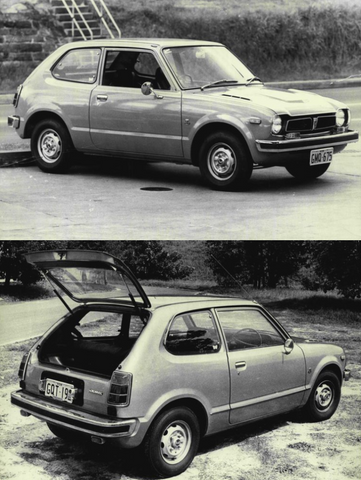JDM Traditional Japanese Car Honda Civic

The Honda Civic is a small passenger car that was launched in 1972. Repeated model changes, now the 11th generation Civic is on sale.
The origin of the car's name is CIVIC, which means "citizen's" in English and means that it was made for mass-market cars.
The first-generation Civic, which appeared in 1972, is also famous as the first model in the world to clear the Muskie Law, which was called "impossible to clear" by world-famous automobile manufacturers.
In addition, it was one that incorporated innovative attempts in packaging, such as adopting a 2-box style and FF drive, which were rare in Japanese cars at the time.
The second-generation (commonly known as the Super Civic), which appeared in 1979, adopted the "centralized target meter" in which the speedometer and tachometer were arranged coaxially in the interior, while maintaining the concept of the previous generation. This model also features the addition of Honda's first station wagon, the Civic Country.
The 3rd generation (commonly known as Wonder Civic), which appeared in 1983, inherited the ``MM philosophy (man, maximum, mechanism, and minimum)'' from the first generation, while greatly renovating the design and mechanism. In addition to 3-door hatchbacks, 4-door bodies, and 5-door hatchback Shuttles were lined up. In 1984, a 1.6-liter DOHC "Si" was added, and achieved good results in the All Japan Touring Car Championship.
The 4th generation (commonly known as the Grand Civic), which appeared in 1987, featured luxurious mechanisms and equipment for this class, such as a design that emphasized wide and low, a significantly improved interior texture, and the adoption of a 4-wheel double wishbone suspension. Many were adopted.
The 5th generation (commonly known as Sports Civic), which appeared in 1991, inherited the same low and wide proportions as its predecessor, and also featured a wide range of powertrains. The lineup included 1.3 liters, 1.5 liters, 1.6 liters, and 1.6 liters DOHC VTEC. Due to the evolution of the chassis and suspension, it was a model with a high balance between running and handling.
The 6th generation (common name: Miracle Civic), which appeared in 1995, was a model that adopted a more sporty style with a 3-door that laid down the C pillar and improved livability, even though it was a keep concept.
The 7th generation, which appeared in 2000, has only a 5-door hatchback, and the design has changed significantly to a model closer to a tall wagon.
The 8th generation, which appeared in 2005, expanded the overall width from the 5-number frame to the 3-number frame.
Also, the lineup has been reduced to only 4-door sedans.
With this 8th generation, sales in the Japanese market ended, and from the 9th generation onwards production and sales were limited to overseas.
The ninth-generation Civic, which appeared in 2011, was only sold overseas and was not sold in Japan.
In 2017, the 10th generation Civic was officially announced to be revived in Japan, and in September of the same year, three types of hatchback, sedan, and type R were released.
Characterized by a form that pursued functional beauty based on low and wide, it was a model that expanded the interior space and improved ease of riding, livability, and comfort in the city.
In addition, the advanced safe driving support system "Honda SENSING" was also equipped as standard.
The powertrain was equipped with a 1.5L VTEC turbo engine for all cars.
The 11th generation, which appeared in 2021, has only a 5-door hatchback body, and is elegant and sporty like a 5-door coupe.
The interior has a clean and tidy impression with a horizontal honeycomb panel that extends to the passenger side, an analog display meter panel that serves as a monitor in the center, and switches designed with an emphasis on functionality.
Let's pay attention to the ever-evolving Civic.
